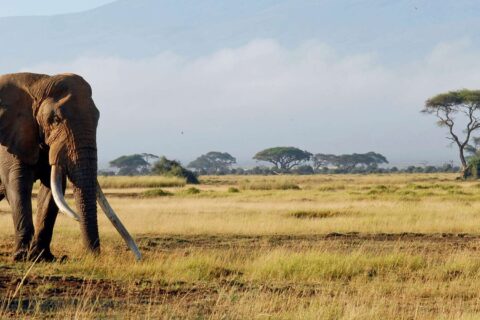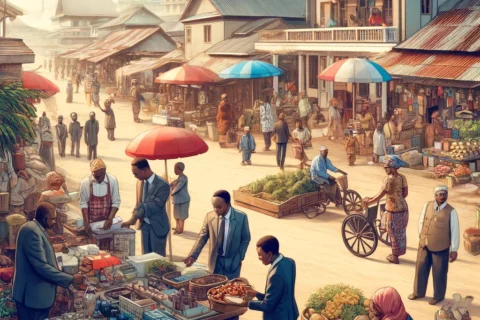History
Brief history of Tanzania
The United Republic of Tanzania
Located in East Africa, the United Republic of Tanzania (Swahili: Jamhuri ya Muungano wa Tanzania) is bordered by Kenya and Uganda to the north, Rwanda, Burundi, and the Democratic Republic of the Congo to the west, and Zambia, Malawi, and Mozambique to the south. To the east, it opens to the Indian Ocean.
Tanzania was formed through the union of two former sovereign entities: Tanganyika on the mainland and the islands of Zanzibar. Tanganyika gained independence from British rule in December 1961, becoming a republic the following year, while Zanzibar achieved independence on December 10, 1963, and transformed into the People’s Republic of Zanzibar following a revolution on January 12, 1964. Together, they formed the United Republic of Tanzania on April 26, 1964.
Baba wa Taifa Mwalimu Julius K. Nyerere
Historical Origins and Influential Leadership
Mwalimu Julius K. Nyerere, Tanzania’s first president, was a visionary leader known for his commitment to unity and justice. Revered as the “Father of the Nation,” Nyerere championed African socialism, or Ujamaa, which promoted collective self-reliance, equality, and community-based development. Under his leadership, Tanzania emerged as a symbol of African independence and progressive political thought.
Ancient Heritage: The Cradle of Humankind
Tanzania is also recognized as a historical epicenter of early human life. The renowned Olduvai Gorge, often called the “Cradle of Mankind,” has revealed some of the oldest evidence of human ancestors. This area, located in northern Tanzania, contains fossils dating back millions of years, including Paranthropus bones over two million years old and the Laetoli footprints, which are the oldest known footprints of human ancestors, estimated at about 3.6 million years old.
Early Inhabitants and Bantu Migrations
Roughly 10,000 years ago, Tanzania was inhabited by hunter-gatherer societies, including those who spoke Khoisan languages. Over time, Cushitic-speaking groups migrated from the north, introducing agriculture and pastoralism. By 2000 years ago, waves of Bantu-speaking people began arriving from West Africa, bringing with them ironworking skills and social organization practices that would shape the region. Nilotic pastoralists also arrived later, completing the mosaic of Tanzania’s early populations.
Swahili Culture and Trade Expansion
By the early first millennium CE, Tanzania’s coast was a center for trade, especially with merchants from Arabia and Persia, which spurred economic and cultural growth. The coastal trade network introduced Islam and fostered the development of the Swahili language, an East African lingua franca. Swahili emerged as a blend of Bantu, Arabic, and Persian influences due to vibrant interactions with Arab, Persian, and Indian traders. This language and culture spread along the East African coast and the islands of Zanzibar, Kilwa, and Comoros.
During the Shirazi Era (13th-15th centuries), Swahili city-states flourished, trading ivory, gold, and other goods as far as India and China. The Swahili influence extended beyond Tanzania, reaching Madagascar, central Africa, and the Great Lakes region. Ibn Battuta, the renowned Berber traveler, visited Kilwa in the early 1300s and declared it one of the world’s finest cities. Kilwa was among the earliest cities to use currency, underscoring its economic significance.
Colonial Era and European Exploration
Portuguese explorers, beginning with Vasco da Gama in 1498, were the first Europeans to reach the East African coast, eventually asserting control over coastal areas by 1525. Their dominance lasted until the early 18th century when the Omani Arabs established a lasting influence. Zanzibar became central to the Arab slave trade, and this period led to a mistaken view that Swahili civilization was primarily Arab-influenced—a misconception that has since been re-evaluated to emphasize its African origins. The 19th century saw growing European interest, with explorers like Johannes Rebmann, who sighted Mount Kilimanjaro in 1848, and David Livingstone, who ventured into the interior of Africa. Livingstone’s quest to trace the Nile’s source culminated in his famous encounter with journalist Henry Morton Stanley in Ujiji on Lake Tanganyika’s shores, immortalized by the words, “Dr. Livingstone, I presume?”
The British, French, and Dutch later visited Zanzibar, and in 1873, the British pressured Sultan Barghash to end the slave trade. Although this slowed the trade, illegal trafficking continued in limited forms. Germany’s interest grew during the late 19th century, establishing control over what would later be called Tanganyika. By the 1880s, Germany had claimed much of East Africa, with Britain focusing on Uganda and Kenya. The two powers partitioned the region, leaving Zanzibar under Omani rule, while Germany and Britain agreed on colonial boundaries in 1886.
World War I and the Path to Independence
During World War I, British forces took control of German East Africa. Following the war, the League of Nations mandated Tanganyika to Britain. Under British rule, Tanganyika served as a base during World War II and contributed resources to the Allied effort. Political changes accelerated after the war, leading to Tanganyika’s independence in December 1961, with Mwalimu Julius K. Nyerere as its first prime minister. He continued as president after Tanganyika became a republic in 1962.
Formation of Tanzania and Modern Governance
In 1964, Tanganyika united with Zanzibar, forming the United Republic of Tanzania. Nyerere’s Ujamaa policies emphasized African socialism, equality, and communal progress. Tanzania’s approach to governance prioritized peace and stability, making it a model for other African nations. The country has maintained consistent democratic practices, holding presidential and parliamentary elections every five years.
Tanzania Today
Today, Tanzania is known for its natural beauty, rich biodiversity, and significant cultural heritage. Sites like the Serengeti, Mount Kilimanjaro, and the Ngorongoro Crater attract millions of tourists each year. The country’s blend of traditional and modern cultures, along with its historic legacy, continues to make it a unique and fascinating destination.


